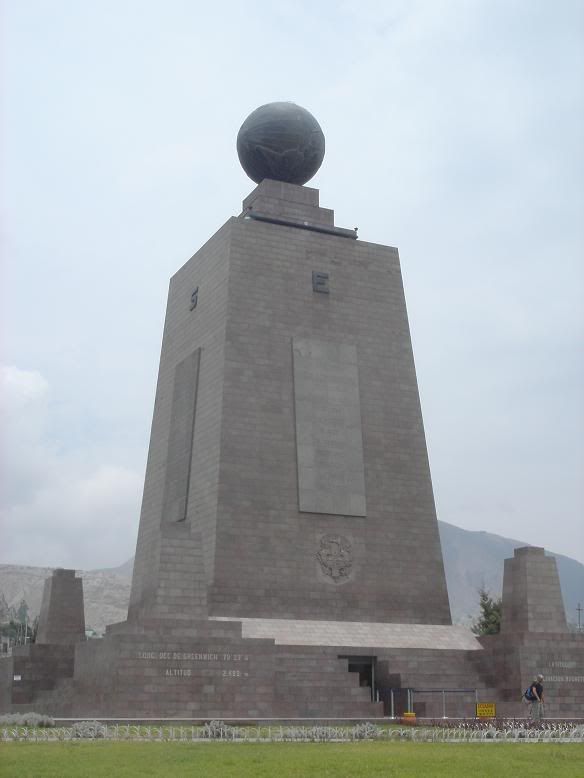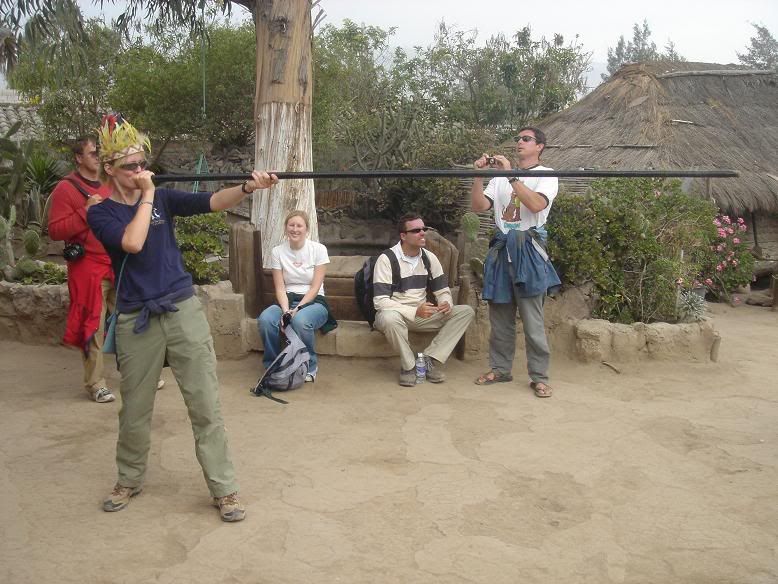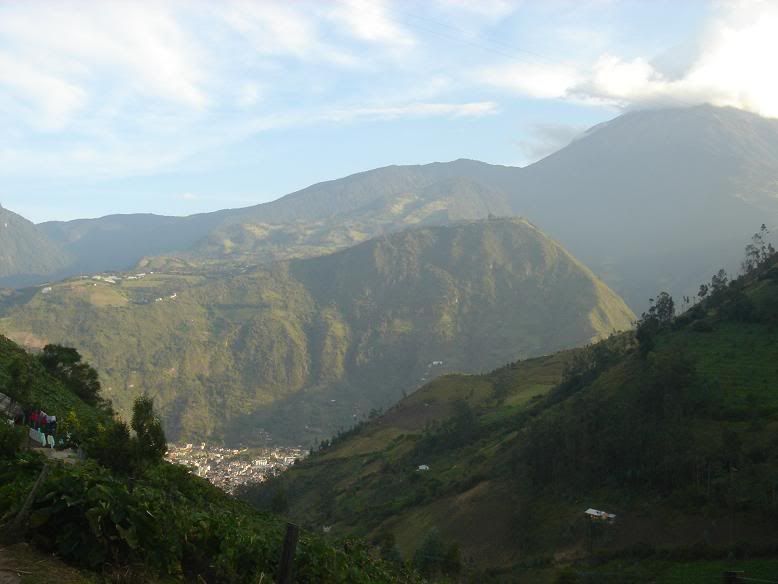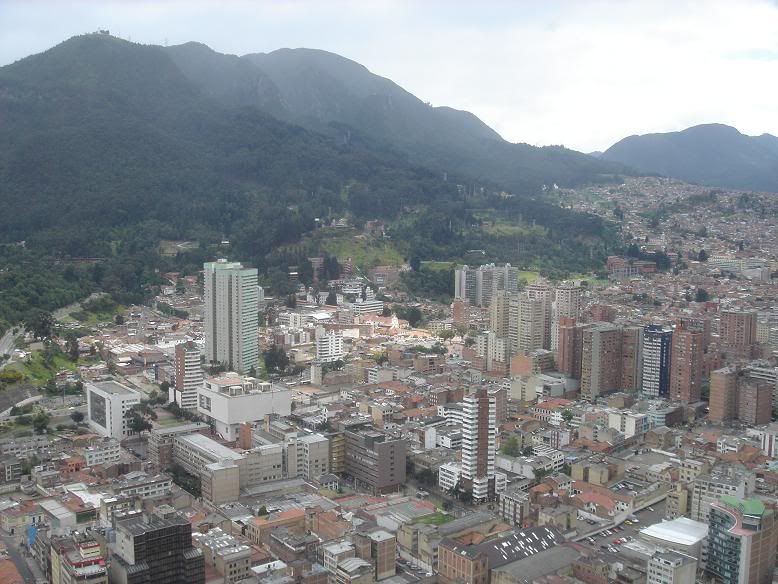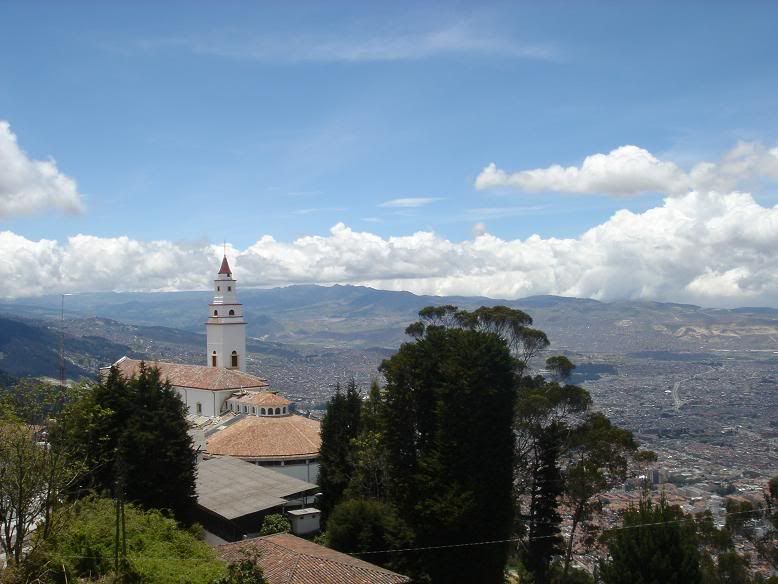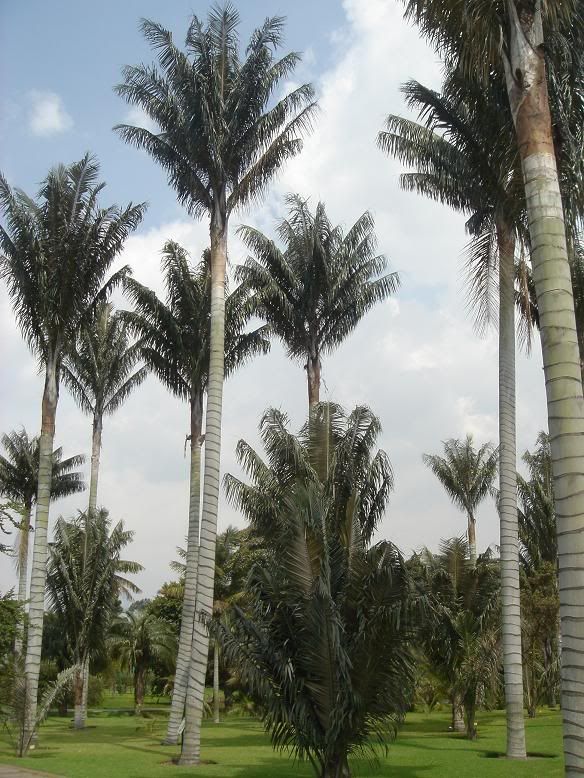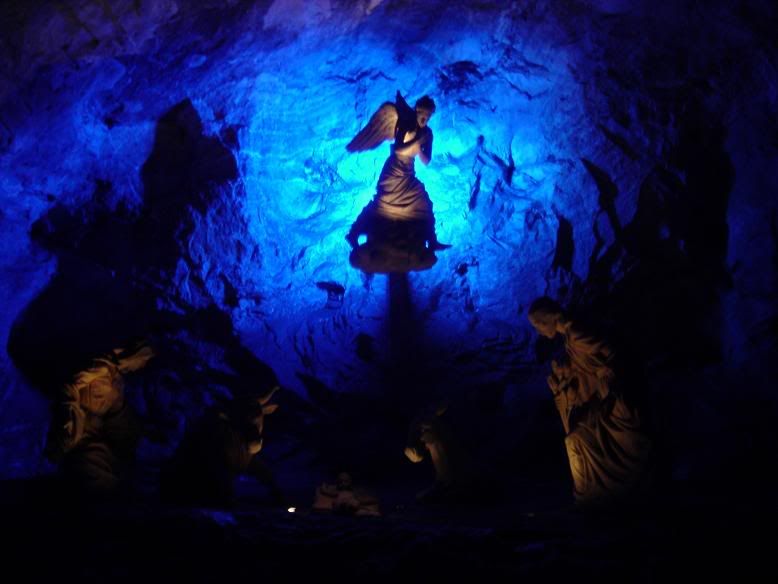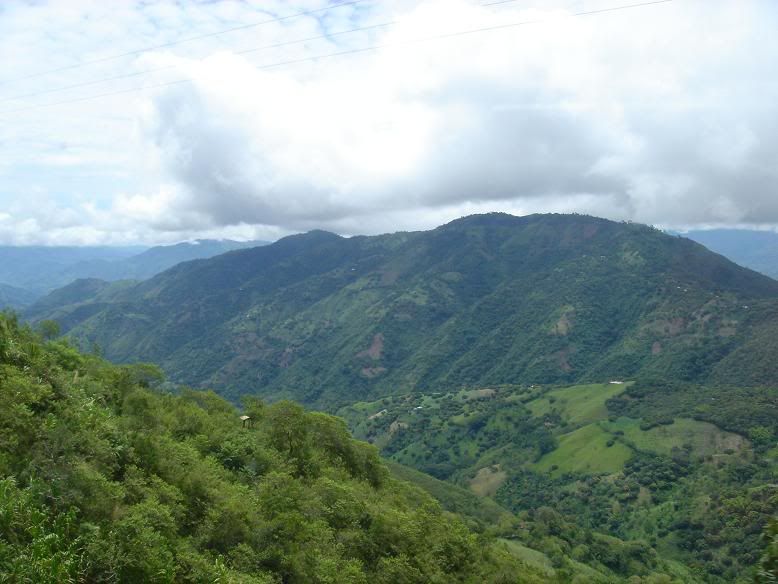
Landscape en-route
We arrived in Manizales and eventually reached our hostel after landing ourselves with a taxi driver who clearly lacked The Knowledge. There we bumped into Angie and Meredith, our travelling chums from the previous week, who were very excited to be going to see Juanes in concert in the stadium opposite the hostel. Juanes is the South American answer to Robbie Williams, and is actually very good - we listened to the concert from outside our hostel.
The following day we looked around the city. The centre of town, which sits at the top of a mountain ridge, is dominated by a huge and exceptionally ugly cathedral - the design is OK, but it the use of concrete to build it makes it look like a gothic inspired 70's highrise. Despite it's position as the capital of the coffee region, it really wasn't that interesting so we spent the rest of the afternoon looking in shopping malls and writing the Blog.
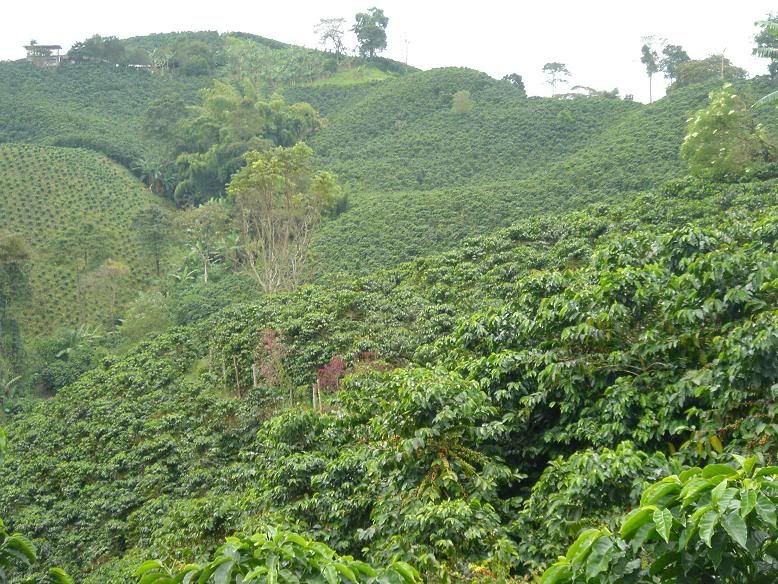
Hill sides of coffee
The following day we went in search of an authentic coffee experience, in the small town of Chinchina. This market town receives coffee beans from the whole region, and as it was a Saturday it was bursting at the seams with trucks, mules, drunken men and coffee. In fact it was like something out of the Wild West, lots of bars with billards, lots of men in cowboy hats drinking, and very few women about....
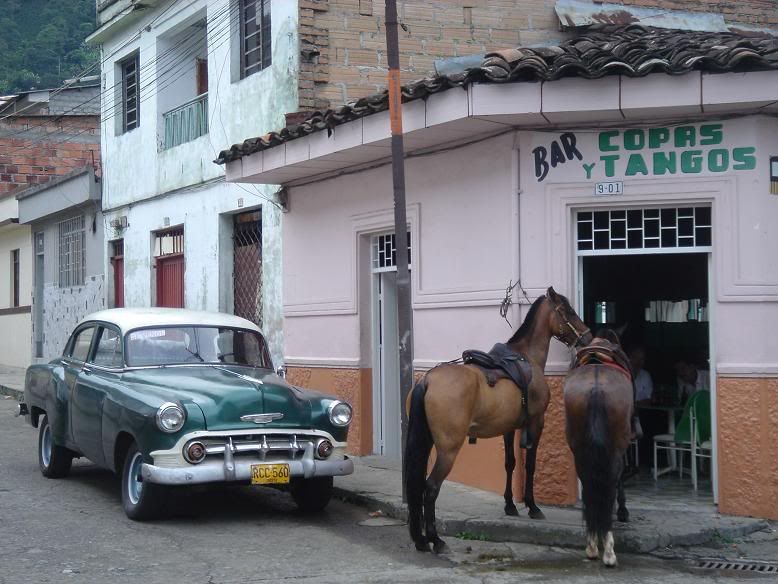
So wild even the horses drink!
After wandering around, we met up with the son of patrón 'Don Carlos' (ever a cartel name if ever I heard one!!) , who showed us the way to his father's coffee finca, where we were to spend the night. Unfortunately this involved a steep climb up a hill side to his coffee farm aptly named Colina del sol, or Hill of the Sun. There we were given indepth explanation of the ins and outs of coffee growing, including the fight against the dreaded coffee rust and berry borer. We then spent the rest of the afternoon relaxing, enjoying the peace, tranquility and copious amounts of home grown coffee (Hannah slowly began to even enjoy a cup). The views from the finca were excellent, and as night fell we spent a very quiet evening reading before turning in for a good nights sleep.
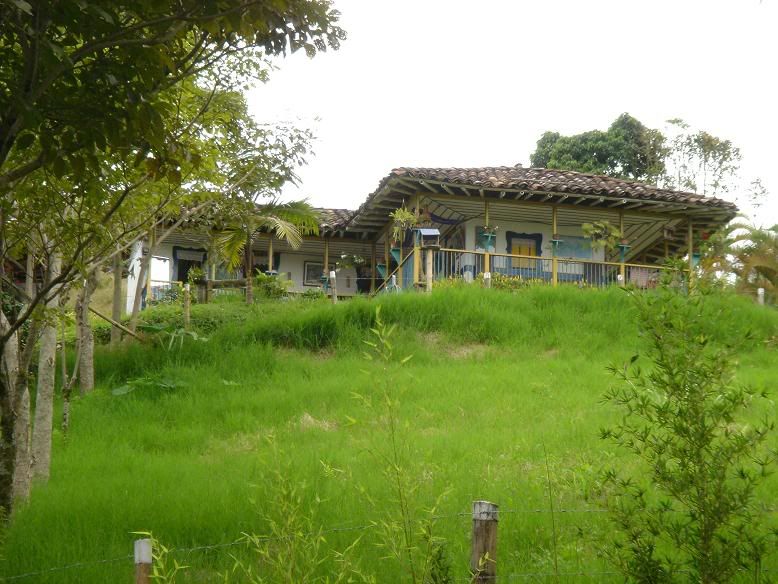
Coffee finca
The following morning was more of the same - relaxing, reading and coffee drinking. We had tour around another part of the finca with a half mad local who would abruptly stop, mid sentence, to go and hug a tree and quote Pablo Neruda - weird! After a leisurely lunch we headed back downhill to Chinchina and from there back to our hostel in Manizales, with several abortive attempts to buy coffee enroute.
The next day we caught an early bus to Medellín, a city once synonymous with drug cartels and violence, but now a prospering and vibrant (and safe) city. We arrived in the excellent bus terminal and headed to the centre of town to look around before heading off on a night bus to Cartagena on the Caribbean coast. The centre was not great, full of crazy people and women of negotiable affection. There were some wonderful sculptures by the local artist, Botero, a big brick cathedral but aside from that not a lot else. Later we found out that the nice part of town is in the south, but we didn't mind - we wanted to get to the beach so left quicksmart.

Bronze horse by Botero
We arrived in Cartagena later than promised, after an interminable number of police checks. It was hot and very humid, and noticeably poorer than other parts of Colombia. We installed ourselves in a cheap hotel with a very big fan, and had a quick walk around town before heading back to catch up on the sleep that we missed on our overnight bus.
Cartagena is one of the oldest cities in in South America, given it's position in the Caribbean close to where Colombus first made landfall. Since it was first founded in 1521 every pirate worth his salt in the centuries since has sacked the city - or at least tried to. Because of this, huge walls encircle the old town of Cartagena - well protected anyway by a maze of small islands and narrow straits and sheltered harbours. Within the walls are possibly the finest collection of colonial architecture in South America, with old churches and brightly painted ancient town houses lining the narrow streets and tranquil plazas.

Pretty streets of Cartagena
We spent our day in Cartagena wandering around fairly aimlessly; first was circuit of the walls, incredibly thick and pretty well preserved and restored. After this we made our way slowly back throught the heart of the old town; the narrow streets were cooler in the shade and outside of the busy central area were quiet areas where gardens spilled out from courtyards onto the street. Cartagena was also the first place in Colombia we had seen any number of Western tourists, and with them came lots of street vendors anxious to sell their wares.
Much as we liked Cartagena, when it's 90° in the shade, there's only one place to be, and that isn't in a city. So the following morning we took a taxi to a rickety pier in a dirty market, from where boats were supposed to leave for Playa Blanca, reputedly the best beach in Colombia. After agreeing to an over-the-odds price, we waited for over 2 hours for the boat to fill up, and we on the point of giving up and going home when the boat pulled away and set off at a fearsome speed.
After a 50 minute rollercoaster ride, we were dropped on at the beach. It looked as good as it was cracked up to be - white sand, very warm and blue sea, coconut trees overhanging the beach..... all we needed was somewhere to stay. We found ourselves in an agreeable beachfront cabin, in a half-empty complex run by an evangelical Frenchman named Gilbert.
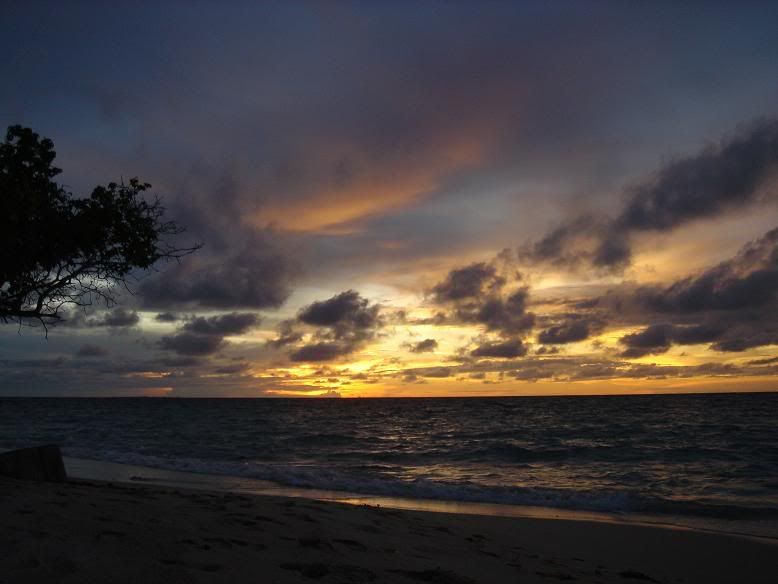
Sunset at Playa Blanca
And so we embarked on some serious lazing around - the afternoon, following day and morning after that were alternate bouts of reading, sunbathing (I'm not a natural), swimming, and eating. It was great. Of the few other guests at the hostel there were two young Colombian brothers with their 4 collected children in tow, plus 3 friendly Israelis.
After almost exhausting my reading, I started on an evolutionary-creationsim book, one of Gilbert's finest. It was interesting.... but here is not the time or place to talk about it! In the evenings we enjoyed freshly caught fish and played Janiv, an entertaining Israeli card game. By Saturday afternoon our money and suncream supplies were runnning low so we took a boat with the Colombian family back to Cartagena, a much more pleasant experience than the way out. I didn't take the Spanish-English New Testament that Gilbert offered; we have plenty too many books already.

"Wish you were here...."
We stayed the night in Cartagena - hot and wet still - before departing the following morning to the port of Santa Marta, further north up the coast. Our main reason for visitng here was not the dirty beach in town, but the Tayrona National Park that lies just to the east - a wild stretch of coastline and beaches that everyone seems to love.
We stayed a night in Santa Marta to buy supplies, and later left the supermarket proud owners of a $10 tent and fridge box, plus all the supplies that we needed for a few days at the beach. We stayed in a very friendly and well equipped hotel, who were only too keen to give us the lowdown on Tayrona.
The following morning, laden with 15 litres of water, a crate of beer, lots of food and a few clothes, we walked to get the bus to the park entrance. We were half dead after walking the 10 blocks necessary, and once we reached the park we opted to do the sensible thing and hire a mule to take our luggage to the beach we wanted to go to.
The hour long walk was through beautiful, pristine jungle, and we arrived at the first beach after 30 minutes and determined to continue onto El Cabo, a beach further on that we had heard good things about. Despite the 80° heat it was overcast and drizzling, and it seemed to be getting greyer as we reached El Cabo. We set up the tent and I entered boy-scout mode, spending an hour or two building a wooden frame around the tent to support a plastic groundsheet which would provide the waterproofing (it was a $10 tent after all). We spent the rest of the afternoon under the shelter that belonged to the campsite - considering they could charge whatever they wanted for food and drinks, it was exceptionally reasonable.
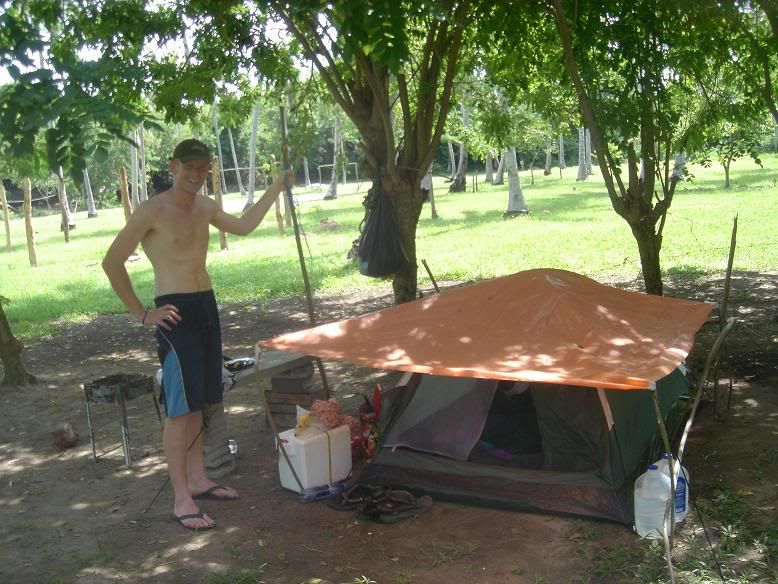
Boy-scout Pete, Ray Mears eat your heart out!
It was Monday, and we only had until Friday before we had to return to Bogota. The first evening we discovered that the "beer" we had bought was in fact a revolting malt drink - very embarrassing, and we had no intention of carrying it back. Fortunately there was the option to buy beer from the camp store, but we were pretty limited on cash so had to nurse our cans carefully.

El Cabo beach
On Tuesday afternoon Limon, Asi and Lee, the Israelis from Playa Blanca, appeared along with a group of 10 or so more if their countrymen. So we spent the days on the beach much as before - reading, sunbathing, swimming, and eating. Our food supplies were perfect, and the fridge box pretty good - we had fresh bread every day until we left, and even managed to exchange the "beer" cans for real beer at the camp shop.
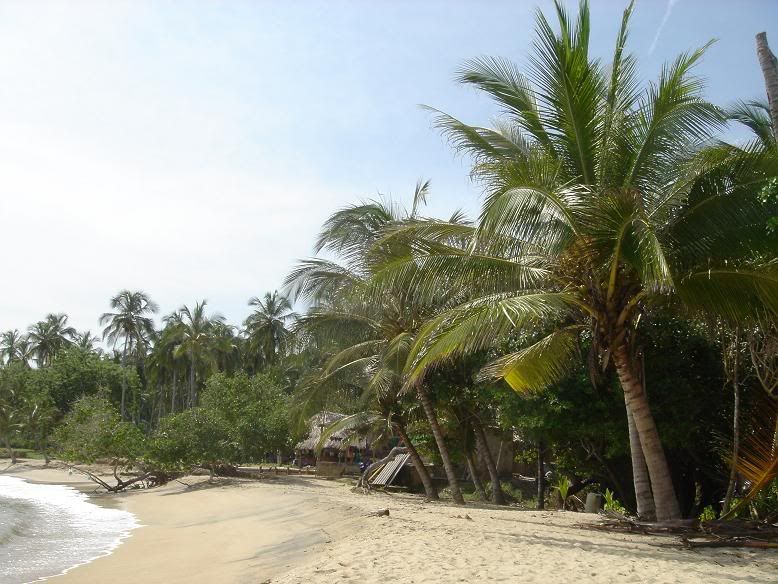
El Cabo beach....again
If you want to be picky, I suppose the sand on the beach of Playa Blanca was better, but the isolation of El Cabo, the lack of vendors and jungle rising immediately behind the beach gave it the edge. Despite having some totally ineffective sunblock (the most expensive in Cartagena) and getting burnt, we had a great time - even during the tropical downpour that just about flooded the tent.
Friday morning came all too quickly, and we struck camp, gathered up all that we couldn't leave behind and walked back to the road - no mule this time. On the way we say some monkeys - an as-yet unidentified species that is the ninth type we have seen.
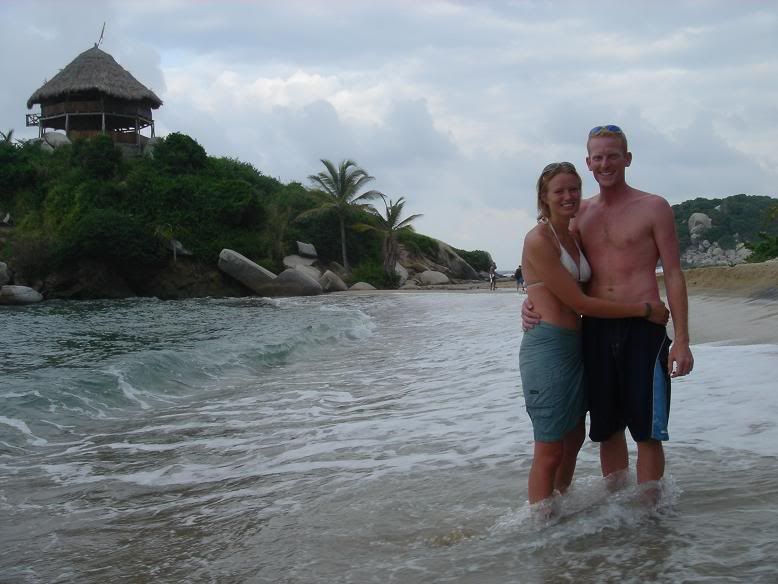
How romantic!
We got back to Santa Marta with only about 25p in our pockets - we had calculated our camping and transport bill rather closely. After a much-needed shower we got lunch and supplies for the long bus ride back to Bogota. We rocked up at the terminal mid-afternoon and stepped onto our bus a short while later, after a bidding war between touts for different companies let us get a cheap seat.
The bus back was due to arrive at 9am, but en route back up the Magdalena valley there was heavy, sustained rain, and our progress slowed to a crawl for several hours. When light came, we were still miles from Bogota, and eventually rolled into the city at midday, 19 hours after we started.
In Bogota it was all go; back in the Platypus hostel, the ever helpful German sorted us with a room and laundry, and we left for some last mintue shopping and culture - there is a free Botero museum here that we missed the other week. That evening we had a great last meal then free beer back at the hostel, before turning in not early enough for our 4am start to the airport.
We're in Mexico City now, only a few days before heading home. We'll see you soon.
